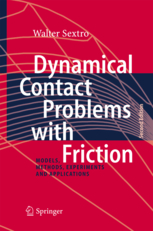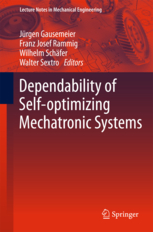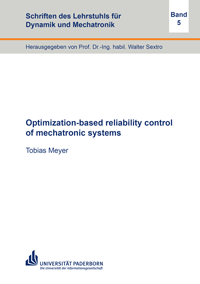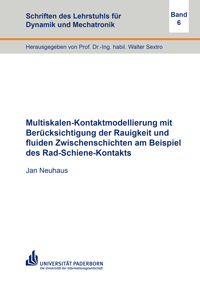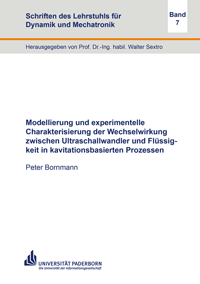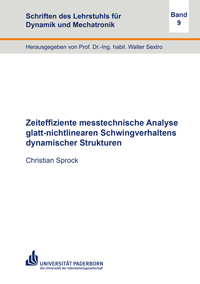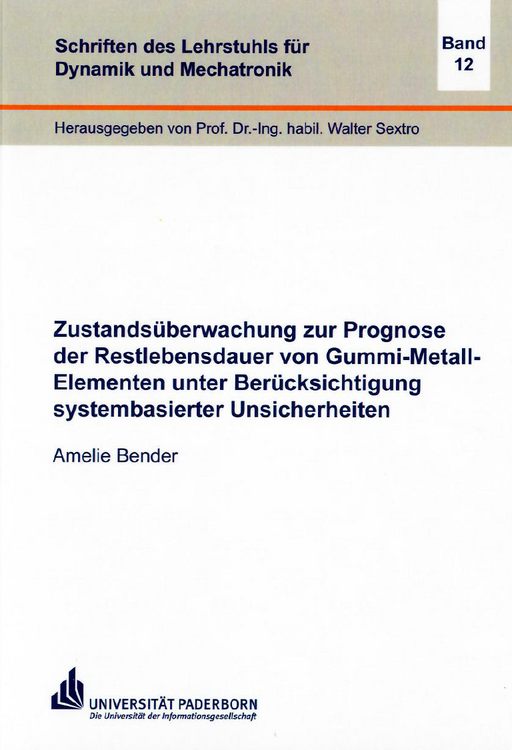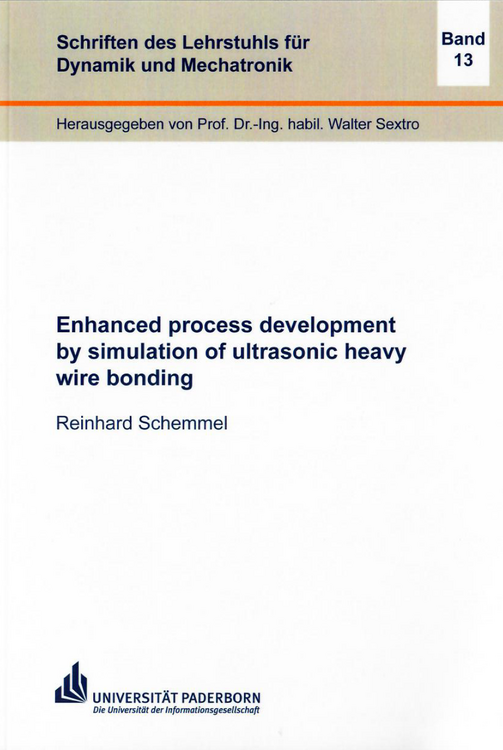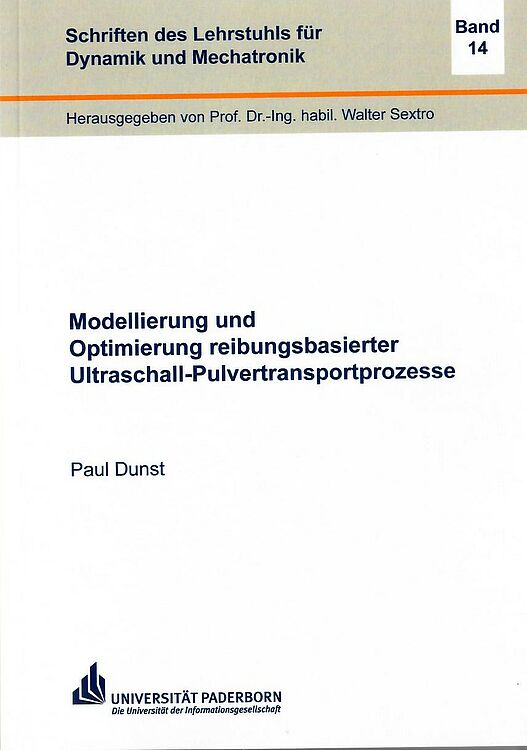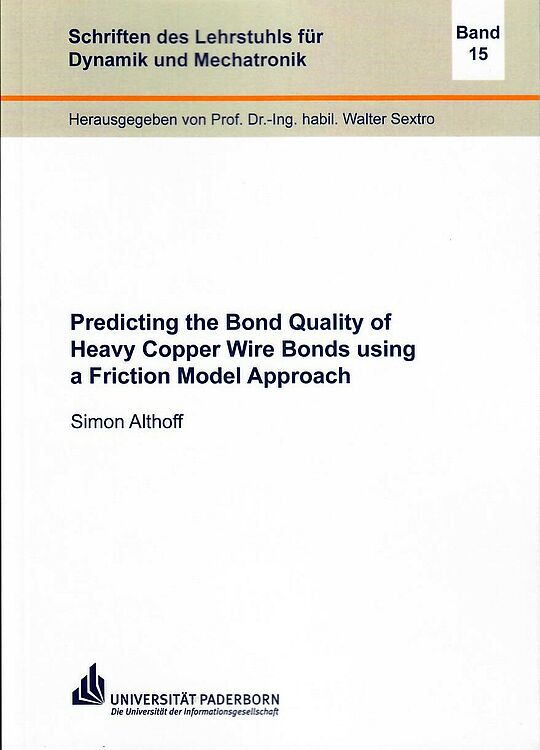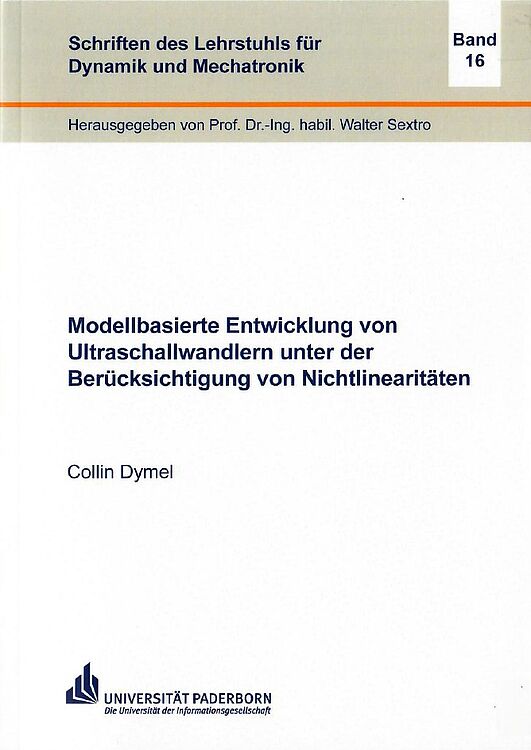Buchpublikationen
Dissertationen
Publikationen aus RIS
Facilitating the Automated Generation of Data-Driven Models for the Diagnostics and Prognostics of Technical Systems
Löwen, A., Quirin, D., Hesse, M., Aimiyekagbon, O. K., & Sextro, W. (2025). Facilitating the Automated Generation of Data-Driven Models for the Diagnostics and Prognostics of Technical Systems. 2025 IEEE 30th International Conference on Emerging Technologies and Factory Automation (ETFA). 2025 IEEE 30th International Conference on Emerging Technologies and Factory Automation (ETFA), Porto. https://doi.org/10.1109/etfa65518.2025.11205799
Surrogate-Assisted Multi-objective Design of Complex Multibody Systems
Amakor, A. C., Berkemeier, M. B., Wohlleben, M. C., Sextro, W., & Peitz, S. (2025). Surrogate-Assisted Multi-objective Design of Complex Multibody Systems. In Lecture Notes in Computer Science. Springer Nature Switzerland. https://doi.org/10.1007/978-3-032-04555-3_21
Sensitivity Analysis and Material Parameter Estimation of a Pre-Stressed Langevin Transducer
Friesen, O., Scheidemann, C., Claes, L., Hemsel, T., & Henning, B. (2025). Sensitivity Analysis and Material Parameter Estimation of a Pre-Stressed Langevin Transducer. 2025 International Congress on Ultrasonics, 138–141. https://doi.org/10.5162/ultrasonic2025/a18-a4
Time dependent material characteristics of prestressed piezoelectric ceramics in langevin transducers
Scheidemann, C., Hemsel, T., & Sextro, W. (2025). Time dependent material characteristics of prestressed piezoelectric ceramics in langevin transducers. 22nd International Workshop on Piezoelectric Materials and Applications in Actuators (IWPMA), Vilnius, Lithuania.
Investigation of the Setting Behaviour of Mechanically Biased Piezoelectric Ultrasonic Transducers
Scheidemann, C., Porzenheim, J., Hemsel, T., & Sextro, W. (2025). Investigation of the Setting Behaviour of Mechanically Biased Piezoelectric Ultrasonic Transducers. 2025 International Congress on Ultrasonics (ICU), Paderborn, Germany.
Prediction of the Frictional Power Distribution in the Tire Contact Patch Based on an Empirical Tire Model and an Artificial Neural Network
Muth, L., Zharia, R., Sahin, H., & Sextro, W. (2025). Prediction of the Frictional Power Distribution in the Tire Contact Patch Based on an Empirical Tire Model and an Artificial Neural Network. Tire Science and Technology. https://doi.org/10.2346/TST-24-009
Lead-Free Ceramics in Prestressed Ultrasonic Transducers
Scheidemann, C., Bornmann, P., Littmann, W., & Hemsel, T. (2025). Lead-Free Ceramics in Prestressed Ultrasonic Transducers. Actuators, 14(2), Article 55. https://doi.org/10.3390/act14020055
Characteristic behavior of lead-free and lead-containing piezo ring ceramics in ultrasonic transducers
Scheidemann, C., Hemsel, T., & Sextro, W. (2024). Characteristic behavior of lead-free and lead-containing piezo ring ceramics in ultrasonic transducers. 21nd International Workshop on Piezoelectric Materials and Applications in Actuators (IWPMA), Hannover, Germany.
Filter-based feature selection for prognostics incorporating cross correlations and failure thresholds
Löwen, A., Wissbrock, P., Bender, A., & Sextro, W. (2024). Filter-based feature selection for prognostics incorporating cross correlations and failure thresholds. PHM Society European Conference, 8(1), 955–964. https://doi.org/10.36001/phme.2024.v8i1.4075
Remaining Useful Lifetime Estimation of Bearings Operating under Time-Varying Conditions
Javanmardi, A., Aimiyekagbon, O. K., Bender, A., Kimotho, J. K., Sextro, W., & Hüllermeier, E. (2024). Remaining Useful Lifetime Estimation of Bearings Operating under Time-Varying Conditions. PHM Society European Conference, 8(1), Article 9. https://doi.org/10.36001/phme.2024.v8i1.4101
Diagnostics and Prognostics for Retrofitted Systems: A Comprehensive Approach for Enhanced System Health Assessment
Bender, A., Aimiyekagbon, O. K., & Sextro, W. (2024). Diagnostics and Prognostics for Retrofitted Systems: A Comprehensive Approach for Enhanced System Health Assessment. Proceedings of the 2024 Prognostics and System Health Management Conference (PHM). 2024 Prognostics and System Health Management Conference (PHM), Stockholm, Schweden. https://doi.org/10.1109/PHM61473.2024.00038
Modellbasierte Entwicklung von Ultraschallwandlern unter der Berücksichtigung von Nichtlinearitäten
Dymel, C. (2024). Modellbasierte Entwicklung von Ultraschallwandlern unter der Berücksichtigung von Nichtlinearitäten (Vol. 16). Shaker Verlag.
Diagnostics of Piezoelectric Bending Actuators Subjected to Varying Operating Conditions
Aimiyekagbon, O. K., Bender, A., Hemsel, T., & Sextro, W. (2024). Diagnostics of Piezoelectric Bending Actuators Subjected to Varying Operating Conditions. Electronics, 13(3), Article 521. https://doi.org/10.3390/electronics13030521
Expert-Informed Hierarchical Diagnostics of Multiple Fault Modes of a Spacecraft Propulsion System
Aimiyekagbon, O. K., Löwen, A., Bender, A., Muth, L., & Sextro, W. (2023). Expert-Informed Hierarchical Diagnostics of Multiple Fault Modes of a Spacecraft Propulsion System. Proceedings of the Asia Pacific Conference of the PHM Society 2023 , 4(1). https://doi.org/10.36001/phmap.2023.v4i1.3596
Einfluss der Radhubkinematik auf den Reifenverschleiß
Schütte, J., & Sextro, W. (2023). Einfluss der Radhubkinematik auf den Reifenverschleiß. 20. VDI-Fachtagung Reifen - Fahrwerk - Fahrbahn, 2425, 165–180.
Influence of Temperature and Pre-Stress on the Piezoelectric Material Behavior of Ring-Shaped Ceramics
Scheidemann, C., Hemsel, T., Friesen, O., Claes, L., & Sextro, W. (2023). Influence of Temperature and Pre-Stress on the Piezoelectric Material Behavior of Ring-Shaped Ceramics. International Conference on Functional Materials & Devices 2023 (ICFMD 2023), Incheon, Korea.
Influence of Temperature and Pre-Stress on the Piezoelectric Material Behavior of Ring-Shaped Ceramics
Scheidemann, C., Hemsel, T., Friesen, O., Claes, L., & Sextro, W. (2023). Influence of Temperature and Pre-Stress on the Piezoelectric Material Behavior of Ring-Shaped Ceramics. 7th International Conference on Advanced Electromaterials (ICAE 2023), Jeju, Korea.
Experimental Investigation of Bond Formation and Wire Deformation in the Ultrasonic Wire Bonding Process
Scheidemann, C., Hagedorn, O. E. C., Hemsel, T., & Sextro, W. (2023). Experimental Investigation of Bond Formation and Wire Deformation in the Ultrasonic Wire Bonding Process. International Conference on Functional Materials & Devices 2023 (ICFMD 2023), Jeju, Korea.
Burst Mode of Ultrasonic Resonant Oscillations for Stimulation and Destruction of Tumor Cells
Sehlmeyer, B., Kampmann, R., Scheidemann, C., Hemsel, T., & Getzlaff, M. (2023). Burst Mode of Ultrasonic Resonant Oscillations for Stimulation and Destruction of Tumor Cells. In Deutsche Physikalische Gesellschaft e. V. (Ed.), Frühjahrstagung 2023, Sektion Kondensierte Materie (SKM).
Burst Mode Characteristics of an Ultrasonic Transducer for Treatment of Cancer Cells
Kampmann, R., Sehlmeyer, B., Scheidemann, C., Hemsel, T., & Getzlaff, M. (2023). Burst Mode Characteristics of an Ultrasonic Transducer for Treatment of Cancer Cells. In Deutsche Physikalische Gesellschaft e. V. (Ed.), Frühjahrstagung 2023, Sektion Kondensierte Marterie (SKM).
Transferability of a discrepancy model for the dynamics of electromagnetic oscillating circuits
Wohlleben, M. C., Muth, L., Peitz, S., & Sextro, W. (2023). Transferability of a discrepancy model for the dynamics of electromagnetic oscillating circuits. Proceedings in Applied Mathematics and Mechanics. https://doi.org/10.1002/pamm.202300039
Model-based condition monitoring of piezoelectric bending actuators
Bender, A. (2023). Model-based condition monitoring of piezoelectric bending actuators. Sensors and Actuators A: Physical, 357, Article 114399. https://doi.org/10.1016/j.sna.2023.114399
Modellierung und Optimierung reibungsbasierter Ultraschall-Pulvertransportprozesse
Dunst, P. (2023). Modellierung und Optimierung reibungsbasierter Ultraschall-Pulvertransportprozesse (Vol. 14). Shaker.
Predicting the Bond Quality of Heavy Copper Wire Bonds using a Friction Model Approach
Althoff, S. (2023). Predicting the Bond Quality of Heavy Copper Wire Bonds using a Friction Model Approach (Vol. 15). Shaker.
Modellbasierte Ermittlung optimaler Prozessparameter für neuartige Ultraschallbondverbindungen
Scheidemann, C., Hemsel, T., & Sextro, W. (2022). Modellbasierte Ermittlung optimaler Prozessparameter für neuartige Ultraschallbondverbindungen. LibreCat University. https://doi.org/10.2314/KXP:1879655276
Patent DE 10 2017 000 926 B4: Gerät mit wenigstens einem elastisch verformbaren Bauteil, insbesondere einem Gummi-Metall-Lager und mit einer Einrichtung zur Feststellung des Beginns einer verschleißbedingten Bauteil-Restnutzungsdauer, sowie Verfahren zur Bestimmung der Bauteil-Restnutzungsdauer.
K. Reinke, A. Bender, T. Meyer, W. Sextro, J.K. Kimotho, International Patent Number: DE: 10 2017 000 926 B4 , Patent Classification: G01M 7/00 (2006.01), 2022.
Experimental Investigation of Multidimensional Ultrasonic Heavy Wire Bonding
Scheidemann, C., Kirsch, O., Hemsel, T., & Sextro, W. (2022). Experimental Investigation of Multidimensional Ultrasonic Heavy Wire Bonding. 2022 IEEE 9th Electronics System-Integration Technology Conference (ESTC). https://doi.org/10.1109/estc55720.2022.9939478
On the applicability of time series features as health indicators for technical systems operating under varying conditions
Aimiyekagbon, O. K., Bender, A., & Sextro, W. (2022). On the applicability of time series features as health indicators for technical systems operating under varying conditions. Condition Monitor, 425, 5–10.
Experimental Investigation of the Influence of different Bond Tool Grooves on the Bond Quality for Ultrasonic Thick Wire Bonding
Hagedorn, O. E. C., Broll, M., Kirsch, O., Hemsel, T., & Sextro, W. (2022). Experimental Investigation of the Influence of different Bond Tool Grooves on the Bond Quality for Ultrasonic Thick Wire Bonding. CIPS 2022 - 12th International Conference on Integrated Power Electronics Systems, 138–143.
Development of a Hybrid Modeling Methodology for Oscillating Systems with Friction
Wohlleben, M. C., Bender, A., Peitz, S., & Sextro, W. (2022). Development of a Hybrid Modeling Methodology for Oscillating Systems with Friction. In Machine Learning, Optimization, and Data Science. Springer International Publishing. https://doi.org/10.1007/978-3-030-95470-3_8
Enhanced process development by simulation of ultrasonic heavy wire bonding
Schemmel, R. (2022). Enhanced process development by simulation of ultrasonic heavy wire bonding (Vol. 13). Shaker. https://doi.org/10.17619/UNIPB/1-1280
Piezoelectric Ultrasonic Power Transducers
Hemsel, T., & Twiefel, J. (2022). Piezoelectric Ultrasonic Power Transducers. In Reference Module in Materials Science and Materials Engineering. Elsevier. https://doi.org/10.1016/b978-0-12-819728-8.00047-4
Generation of a Reduced, Representative, Virtual Test Drive for Fast Evaluation of Tire Wear by Clustering of Driving Data
Muth, L., Noll, C., & Sextro, W. (2022). Generation of a Reduced, Representative, Virtual Test Drive for Fast Evaluation of Tire Wear by Clustering of Driving Data. In A. Orlova & D. Cole (Eds.), Advances in Dynamics of Vehicles on Roads and Tracks II - Proceedings of the 27th Symposium of the International Association of Vehicle System Dynamics, IAVSD 2021. Springer. https://doi.org/10.1007/978-3-031-07305-2_92
Identification of joints for a load-adapted shape in a body in white using steady state vehicle simulations
Martin, S., Schütte, J., Bäumler, C., Sextro, W., & Tröster, T. (2021). Identification of joints for a load-adapted shape in a body in white using steady state vehicle simulations. Forces in Mechanics, 6, Article 100065. https://doi.org/10.1016/j.finmec.2021.100065
Tire Wear Reduction Based on an Extended Multibody Rear Axle Model
Schütte, J., & Sextro, W. (2021). Tire Wear Reduction Based on an Extended Multibody Rear Axle Model. Vehicles, 233–256. https://doi.org/10.3390/vehicles3020015
Rule-based Diagnostics of a Production Line
Aimiyekagbon, O. K., Muth, L., Wohlleben, M. C., Bender, A., & Sextro, W. (2021). Rule-based Diagnostics of a Production Line. In P. Do, S. King, & O. Fink (Eds.), Proceedings of the European Conference of the PHM Society 2021 (Vol. 6, Issue 1, pp. 527–536). https://doi.org/10.36001/phme.2021.v6i1.3042
On the applicability of time series features as health indicators for technical systems operating under varying conditions
Aimiyekagbon, O. K., Bender, A., & Sextro, W. (n.d.). On the applicability of time series features as health indicators for technical systems operating under varying conditions. Proceedings of the Seventeenth International Conference on Condition Monitoring and Asset Management (CM 2021). Seventeenth International Conference on Condition Monitoring and Asset Management (CM 2021).
Hybrid Prediction Method for Remaining Useful Lifetime Estimation Considering Uncertainties
Bender, A., & Sextro, W. (2021). Hybrid Prediction Method for Remaining Useful Lifetime Estimation Considering Uncertainties. In P. Do, S. King, & Olga Fink (Eds.), Proceedings of the European Conference of the PHM Society 2021 (Vol. 6, Issue 1). https://doi.org/10.36001/phme.2021.v6i1.2843
Co-simulation of MATLAB and ANSYS for ultrasonic wire bonding process optimization
Schemmel, R., Krieger, V., Hemsel, T., & Sextro, W. (2021). Co-simulation of MATLAB and ANSYS for ultrasonic wire bonding process optimization. Microelectronics Reliability, 119, 114077. https://doi.org/10.1016/j.microrel.2021.114077
Zustandsüberwachung zur Prognose der Restlebensdauer von Gummi-Metall-Elementen unter Berücksichtigung systembasierter Unsicherheiten
Bender, A. (2021). Zustandsüberwachung zur Prognose der Restlebensdauer von Gummi-Metall-Elementen unter Berücksichtigung systembasierter Unsicherheiten. Shaker. https://doi.org/10.17619/UNIPB/1-1084
Prozessgerechte Gestaltung von Werkzeugen auf Basis von Verschleißsimulationen am Beispiel des Ultraschallbondens
Eichwald, P. (2021). Prozessgerechte Gestaltung von Werkzeugen auf Basis von Verschleißsimulationen am Beispiel des Ultraschallbondens (Vol. 11). Shaker.
A Multi-Model-Particle Filtering-Based Prognostic Approach to Consider Uncertainties in RUL Predictions
Bender, A. (2021). A Multi-Model-Particle Filtering-Based Prognostic Approach to Consider Uncertainties in RUL Predictions. Machines, 9(10), Article 210. https://doi.org/10.3390/machines9100210
Application and modelling of ultrasonic transducers using 1-3 piezoelectric composites with structured electrodes
Dreiling, D., Itner, D., Feldmann, N., Scheidemann, C., Gravenkamp, H., & Henning, B. (2021). Application and modelling of ultrasonic transducers using 1-3 piezoelectric composites with structured electrodes. Fortschritte Der Akustik - DAGA 2021. DAGA 2021 - 47. JAHRESTAGUNG FÜR AKUSTIK, Wien.
Extraktion und Selektion geeigneter Merkmale für die Restlebensdauerprognose von technischen Systemen trotz aleatorischen Unsicherheiten
Aimiyekagbon, O. K., Bender, A., & Sextro, W. (2021). Extraktion und Selektion geeigneter Merkmale für die Restlebensdauerprognose von technischen Systemen trotz aleatorischen Unsicherheiten . VDI-Berichte 2391, 197–210.
Model-Based Investigation of the Influence of Wheel Suspension Characteristics on Tire Wear
Schütte, J., & Sextro, W. (2020). Model-Based Investigation of the Influence of Wheel Suspension Characteristics on Tire Wear. Lecture Notes in Mechanical Engineering. https://doi.org/10.1007/978-3-030-38077-9_201
Patent EP 3 358 332 B1: Verfahren zur Bestimmung des Beginns einer verschleißbedingten Bauteil-Restnutzungsdauer eines elastisch verformbaren Bauteils, als Strukturteil und/oder Lagerteil eines Geräts.
K. Reinke, A. Bender, T. Meyer, W. Sextro, J.K. Kimotho, International Patent Number: EP 3 358 332 B1, Patent Classification: G01M 13/00, 2020.
Evaluation of time series forecasting approaches for the reliable crack length prediction of riveted aluminium plates given insufficient data
Aimiyekagbon, O. K., Bender, A., & Sextro, W. (2020). Evaluation of time series forecasting approaches for the reliable crack length prediction of riveted aluminium plates given insufficient data. PHM Society European Conference, 5(1).
Experimental analysis and modelling of bond formation in ultrasonic heavy wire bonding
Schemmel, R., Scheidemann, C., Hemsel, T., Kirsch, O., & Sextro, W. (2020). Experimental analysis and modelling of bond formation in ultrasonic heavy wire bonding. CIPS 2020; 11th International Conference on Integrated Power Electronics Systems, 1–6.
Co-simulation of MATLAB and ANSYS for ultrasonic wire bonding process optimization
Schemmel, R., Krieger, V., Hemsel, T., & Sextro, W. (2020). Co-simulation of MATLAB and ANSYS for ultrasonic wire bonding process optimization. 2020 21st International Conference on Thermal, Mechanical and Multi-Physics Simulation and Experiments in Microelectronics and Microsystems (EuroSimE). https://doi.org/10.1109/eurosime48426.2020.9152679
Schwingungen
Magnus, K., Popp, K., & Sextro, W. (2020). Schwingungen. Springer Vieweg Wiesbaden. https://doi.org/10.1007/978-3-658-31116-2
Integrierte Modellierung von Zuverlässigkeit und dynamischem Verhalten mechatronischer Systeme
Kaul, T. (2020). Integrierte Modellierung von Zuverlässigkeit und dynamischem Verhalten mechatronischer Systeme (Vol. 10). Shaker. https://doi.org/10.17619/UNIPB/1-966
Halbachsprüfstand zur kinematischen, elastokinematischen und dynamischen Charakterisierung von Radaufhängungen
Schütte, J., Sextro, W., & Kohl, S. (2019). Halbachsprüfstand zur kinematischen, elastokinematischen und dynamischen Charakterisierung von Radaufhängungen. Fachtagung Mechatronik 2019. Fachtagung Mechatronik 2019, Paderborn. https://doi.org/10.17619/UNIPB/1-777
Digital Twin for Reliability Analysis During Design and Operation of Mechatronic Systems
Kaul, T., Bender, A., & Sextro, W. (2019). Digital Twin for Reliability Analysis During Design and Operation of Mechatronic Systems. In M. Beer & E. Zio (Eds.), Proceedings of the 29th European Safety and Reliability Conference (ESREL2019) (Issue 29, pp. 2340–2347).
Remaining useful lifetime prediction based on adaptive failure thresholds
Bender, A., Schinke, L., & Sextro, W. (2019). Remaining useful lifetime prediction based on adaptive failure thresholds. In M. Beer & E. Zio (Eds.), Proceedings of the 29th European Safety and Reliability Conference (ESREL2019) (Issue 29, pp. 1262–1269).
Impact of multi-dimensional vibration trajectories on quality and failure modes in ultrasonic bonding
Schemmel, R., Eacock, F., Dymel, C., Hemsel, T., Hunstig, M., Brökelmann, M., & Sextro, W. (2019). Impact of multi-dimensional vibration trajectories on quality and failure modes in ultrasonic bonding. International Symposium on Microelectronics, 509–514. https://doi.org/10.4071/2380-4505-2019.1.000509
Using complex multi-dimensional vibration trajectories in ultrasonic bonding and welding
Schemmel, R., Hemsel, T., Dymel, C., Hunstig, M., Brökelmann, M., & Sextro, W. (2019). Using complex multi-dimensional vibration trajectories in ultrasonic bonding and welding. Sensors and Actuators A: Physical, 295, 653–662. https://doi.org/10.1016/j.sna.2019.04.025
Zeiteffiziente messtechnische Analyse glatt-nichtlinearen Schwingverhaltens dynamischer Strukturen
Sprock, C. (2019). Zeiteffiziente messtechnische Analyse glatt-nichtlinearen Schwingverhaltens dynamischer Strukturen. Shaker.
Analyse der Reibleistungsverteilung im Reifenlatsch unter Berücksichtigung der Fahrwerkdynamik eines Mehrlenkerachssystems zur Bewertung des Reifenverschleißes
Kohl, S. (2019). Analyse der Reibleistungsverteilung im Reifenlatsch unter Berücksichtigung der Fahrwerkdynamik eines Mehrlenkerachssystems zur Bewertung des Reifenverschleißes. Shaker.
Modellierung und experimentelle Charakterisierung der Wechselwirkung zwischen Ultraschallwandler und Flüssigkeit in kavitationsbasierten Prozessen
Bornmann, P. (2019). Modellierung und experimentelle Charakterisierung der Wechselwirkung zwischen Ultraschallwandler und Flüssigkeit in kavitationsbasierten Prozessen. Shaker.
Messung hochfrequenter In-Plane-Schwingungen mittels Laservibrometrie in räumlich eingeschränkten Umgebungen
Hagedorn, O. E. C., Pielsticker, D., Hemsel, T., & Sextro, W. (2019). Messung hochfrequenter In-Plane-Schwingungen mittels Laservibrometrie in räumlich eingeschränkten Umgebungen. In 2. VDI-Fachtagung Schwingungen 2019. VDI Verlag GmbH · Düsseldorf 2019.
Atomization of Fluids with Ultrasound
Dunst, P., Bornmann, P., Hemsel, T., Littmann, W., & Sextro, W. (2019). Atomization of Fluids with Ultrasound. In J. Lötters & G. Urban (Eds.), Conference Proceedings - The 4th Conference on MicroFluidic Handling Systems (MFHS2019) (pp. 140–143). Enschede, The Netherlands.
Konstruktion und Zustandsüberwachung eines Gummi-Metall-Teils mit integriertem Thermoelement
Bender, A., Reinke, K., & Sextro, W. (2019). Konstruktion und Zustandsüberwachung eines Gummi-Metall-Teils mit integriertem Thermoelement. In 10. VDI-Fachtagung Schwingungen von Windenergieanlagen 2019 (Vol. VDI-Berichte 2346, pp. 241–248). Bremen 2019.
Integration von Verlässlichkeitsmodellen der Entwicklung in einen Digitalen Zwilling zur Umsetzung einer vorausschauenden Instandhaltung
Kaul, T., Hentze, J., Sextro, W., & Gräßler, I. (2019). Integration von Verlässlichkeitsmodellen der Entwicklung in einen Digitalen Zwilling zur Umsetzung einer vorausschauenden Instandhaltung. In Fachtagung Mechatronik 2019 Paderborn.
Modellbasierte und experimentelle Charakterisierung von intensiven Ultraschall-Stehwellenfeldern für die Zerstäubung hochviskoser Flüssigkeiten
Dunst, P., Hemsel, T., Bornmann, P., Littmann, W., & Sextro, W. (2019). Modellbasierte und experimentelle Charakterisierung von intensiven Ultraschall-Stehwellenfeldern für die Zerstäubung hochviskoser Flüssigkeiten. In DAGA 2019. Rostock.
Intelligente Herstellung zuverlässiger Kupferbondverbindungen
Sextro, W., & Brökelmann, M. (2019). Intelligente Herstellung zuverlässiger Kupferbondverbindungen (Vol. VIII). Springer Verlag. https://doi.org/10.1007/978-3-662-55146-2
Optimization-based reliability control of mechatronic systems
Meyer, T. (2018). Optimization-based reliability control of mechatronic systems. Shaker.
Numerical and statistical investigation of weld formation in a novel two-dimensional copper-copper bonding process
Dymel, C., Eichwald, P., Schemmel, R., Hemsel, T., Brökelmann, M., Hunstig, M., & Sextro, W. (2018). Numerical and statistical investigation of weld formation in a novel two-dimensional copper-copper bonding process. In (Proceedings of 7th Electronics System-Integration Technology Conference, Dresden, Germany) (pp. 1–6).
Experimental investigations on the impact of bond process parameters in two-dimensional ultrasonic copper bonding
Dymel, C., Schemmel, R., Hemsel, T., Sextro, W., Brökelmann, M., & Hunstig, M. (2018). Experimental investigations on the impact of bond process parameters in two-dimensional ultrasonic copper bonding. In (Proceedings of 8th Electronics IEEE CPMT Symposium Japan (ICSJ 2018), Kyoto, Japan) (pp. 41–44).
Effects of different working frequencies on the joint formation in copper wire bonding
Schemmel, R., Althoff, S., Sextro, W., Unger, A., Brökelmann, M., & Hunstig, M. (2018). Effects of different working frequencies on the joint formation in copper wire bonding. In CIPS 2018 - 10th International Conference on Integrated Power Electronics Systems (CIPS 2018) (pp. 230–235). Stuttgart, Germany.
Intelligent Production of Wire Bonds using Multi-Objective Optimization – Insights, Opportunities and Challenges
Unger, A., Hunstig, M., Meyer, T., Brökelmann, M., & Sextro, W. (2018). Intelligent Production of Wire Bonds using Multi-Objective Optimization – Insights, Opportunities and Challenges. In In Proceedings of IMAPS 2018 – 51st Symposium on Microelectronics, Pasadena, CA, 2018 (Vol. Vol. 2018, No. 1, pp. 000572-000577.). https://doi.org/10.4071/2380-4505-2018.1.000572
A particle filtering approach for temperature based prognostics
Bender, A., & Sextro, W. (2018). A particle filtering approach for temperature based prognostics. In Safety and Reliability – Safe Societies in a Changing World (pp. 1025–1033). Trondheim, Norway.
Numerical and experimental investigations in ultrasonic heavy wire bonding
Schemmel, R., Hemsel, T., & Sextro, W. (2018). Numerical and experimental investigations in ultrasonic heavy wire bonding. In 6th European Conference on Computational Mechanics (ECCM 6) (pp. 1–12). Glasgow, UK.
Vibration Assisted Dosing, Mixing and Transport of Dry Fine Powders
Dunst, P., Bornmann, P., Hemsel, T., Littmann, W., & Sextro, W. (2018). Vibration Assisted Dosing, Mixing and Transport of Dry Fine Powders. ACTUATOR 2018; 16th International Conference on New Actuators, 142–145.
Vibration-Assisted Handling of Dry Fine Powders
Dunst, P., Bornmann, P., Hemsel, T., & Sextro, W. (2018). Vibration-Assisted Handling of Dry Fine Powders. Actuators 2018, 7(2)., 1–11. https://doi.org/10.3390/act7020018
Steigerung der Intelligenz mechatronischer Systeme
Meyer, T., Kaul, T., Kimotho, J. K., & Sextro, W. (2018). Steigerung der Intelligenz mechatronischer Systeme (Vol. Steigerung der Verlässlichkeit technischer Systeme, pp. 193–213). Springer Nature Switzerland AG. Part of Springer Nature.
Multiskalen-Kontaktmodellierung unter Berücksichtigung der Rauigkeit und fluiden Zwischenschichten am Beispiel des Rad-Schiene-Kontakts
Neuhaus, J. (2017). Multiskalen-Kontaktmodellierung unter Berücksichtigung der Rauigkeit und fluiden Zwischenschichten am Beispiel des Rad-Schiene-Kontakts. Shaker.
Modellbasierte Mehrzieloptimierung zur Herstellung von Ultraschall-Drahtbondverbindungen in Leistungshalbleitermodulen
Unger, A. (2017). Modellbasierte Mehrzieloptimierung zur Herstellung von Ultraschall-Drahtbondverbindungen in Leistungshalbleitermodulen. Universität Paderborn.
Multi-dimensional Ultrasonic Copper Bonding – New Challenges for Tool Design
Eichwald, P., Althoff, S., Schemmel, R., Sextro, W., Unger, A., Brökelmann, M., & Hunstig, M. (2017). Multi-dimensional Ultrasonic Copper Bonding – New Challenges for Tool Design. IMAPSource, Vol. 2017, No. 1.
Entwicklung verlässlicher, intelligenter Systeme
Sextro, W., Meyer, T., Kaul, T., & Kimotho, J. K. (2017). Entwicklung verlässlicher, intelligenter Systeme. In VDI-Berichte 2307–28. Tagung Technische Zuverlässigkeit (TTZ 2017) - Entwicklung und Betrieb zuverlässiger Produkte. (pp. 17–30). Leonberg.
Integrated modeling og behavior and reliability in system development
Hentze, J., Kaul, T., Grässler, I., & Sextro, W. (2017). Integrated modeling og behavior and reliability in system development. In ICED17, 21st International conference on enginieering design (pp. 385–394).
Entwicklung eines Condition Monitoring Systems für Gummi-Metall-Elemente
Bender, A., Kaul, T., & Sextro, W. (2017). Entwicklung eines Condition Monitoring Systems für Gummi-Metall-Elemente. In Verlagsschriftenreihe des Heinz Nixdorf Instituts Band 369, Paderborn, 2017 (pp. 347–358). Wissenschaftsforum Intelligente Technische Systeme (WInTeSys) 2017.
Estimation of Remaining Useful Lifetime of Piezoelectric Transducers Based on Self-Sensing
Kimotho, J. K., Sextro, W., & Hemsel, T. (2017). Estimation of Remaining Useful Lifetime of Piezoelectric Transducers Based on Self-Sensing. In IEEE Transactions on Reliability (pp. 1–10). https://doi.org/10.1109/TR.2017.2710260
Analysis of pipe vibration in an ultrasonic powder transportationsystem
Dunst, P., Hemsel, T., & Sextro, W. (2017). Analysis of pipe vibration in an ultrasonic powder transportationsystem. Elsevier, Sensors and Actuators A 263, 733–736.
Formulation of reliability-related objective functions for design of intelligent mechatronic systems
Kaul, T., Meyer, T., & Sextro, W. (2017). Formulation of reliability-related objective functions for design of intelligent mechatronic systems. SAGE Journals, Vol. 231(4), 390–399. https://doi.org/10.1177/1748006X17709376
Piezoelectric Inertia Motors—A Critical Review of History, Concepts, Design, Applications, and Perspectives.
Hunstig, M. (2017). Piezoelectric Inertia Motors—A Critical Review of History, Concepts, Design, Applications, and Perspectives. Actuators. 2017, 6(1)-7., 1–35. https://doi.org/10.3390/act6010007
Model based optimization of dynamics in adaptive headlamps
Schulze, S., Sextro, W., & Kister, K. (2017). Model based optimization of dynamics in adaptive headlamps. In Proceedings of the 12th International Symposium on Automotive Lighting 2017.
MoRFUS: Mobile Reinigungseinheit für Förderketten basierend auf Ultraschall
Schemmel, R., Hemsel, T., & Sextro, W. (2017). MoRFUS: Mobile Reinigungseinheit für Förderketten basierend auf Ultraschall. In 43. Deutsche Jahrestagung für Akustik (pp. 611–614). Kiel 2017.
Neuartiges Konzept zur Lebensdauerprognose von Gummi-Metall-Elementen
Bender, A., Sextro, W., & Reinke, K. (2017). Neuartiges Konzept zur Lebensdauerprognose von Gummi-Metall-Elementen. In VDI-Berichte 2301 (pp. 49–60).
Modellbasierte Prognose der nutzbaren Restlebensdauer von Gummi-Metall-Elementen
Bender, A., Kimotho, J. K., Kohl, S., Sextro, W., & Reinke, K. (2017). Modellbasierte Prognose der nutzbaren Restlebensdauer von Gummi-Metall-Elementen. In 15. Internationale Schienenfahrzeugtagung (pp. 123–125).
Development and Performance Evaluation of Prognostic Approaches for Technical Systems
Kimotho, J. K. (2016). Development and Performance Evaluation of Prognostic Approaches for Technical Systems. Shaker.
Micro Wear Modeling in Copper Wire Wedge Bonding
Eichwald, P., Unger, A., Eacock, F., Althoff, S., Sextro, W., Guth, K., & Brökelmann, M. (2016). Micro Wear Modeling in Copper Wire Wedge Bonding. In IEEE CPMT Symposium Japan, 2016.
Reliable Manufacturing of Heavy Copper Wire Bonds Using Online Parameter Adaptation
Meyer , T., Unger, A., Althoff, S., Sextro, W., Brökelmann, M., Hunstig, M., & Guth, K. (2016). Reliable Manufacturing of Heavy Copper Wire Bonds Using Online Parameter Adaptation. In IEEE 66th Electronic Components and Technology Conference (pp. 622–628). https://doi.org/10.1109/ECTC.2016.215
Validated Simulation of the Ultrasonic Wire Bonding Process
Unger, A., Schemmel, R., Meyer, T., Eacock, F., Eichwald, P., Althoff, S., … Guth, K. (2016). Validated Simulation of the Ultrasonic Wire Bonding Process. In Wear Modeling in Copper Wire Wedge Bonding. IEEE CPMT Symposium Japan, 2016 (pp. 251–254). IEEE CPMT Symposium Japan.
Shape-Dependent Transmittable Tangential Force of Wire Bond Tools
Althoff, S., Meyer, T., Unger, A., Sextro, W., & Eacock, F. (2016). Shape-Dependent Transmittable Tangential Force of Wire Bond Tools. In IEEE 66th Electronic Components and Technology Conference (pp. 2103–2110). https://doi.org/10.1109/ECTC.2016.234
Kupferbondverbindungen intelligent herstellen
Brökelmann, M., Unger, A., Meyer, T., Althoff, S., Sextro, W., Hunstig, M., … Guth, K. (2016). Kupferbondverbindungen intelligent herstellen. Wt-Online, 7/8, 512–519.
Modeling of Complex Redundancy in Technical Systems with Bayesian Networks
Kaul, T., Meyer, T., & Sextro, W. (2016). Modeling of Complex Redundancy in Technical Systems with Bayesian Networks. In Proceedings of the Third European Conference of the Prognostics and Health Management Society 2016.
Effect of different oxide layers on the ultrasonic copper wire bond process
Eacock, F., Unger, A., Eichwald, P., Grydin, O., Hengsbach, F., Althoff, S., … Guth, K. (2016). Effect of different oxide layers on the ultrasonic copper wire bond process. In IEEE 66th Electronic Components and Technology Conference (pp. 2111–2118). https://doi.org/10.1109/ECTC.2016.91
Condition Monitoring of Bearing Damage in Electromechanical Drive Systems by Using Motor Current Signals of Electric Motors: A Benchmark Data Set for Data-Driven Classification
Lessmeier, C., Kimotho, J. K., Zimmer, D., & Sextro, W. (2016). Condition Monitoring of Bearing Damage in Electromechanical Drive Systems by Using Motor Current Signals of Electric Motors: A Benchmark Data Set for Data-Driven Classification. In European Conference of the Prognostics and Health Management Society.
Using Adequate Reduced Models for Flexible Multibody Systems of Automotive Mechatronic Systems
Schulze, S., Sextro, W., & Kohl, S. (2016). Using Adequate Reduced Models for Flexible Multibody Systems of Automotive Mechatronic Systems. In 2nd International Conference on Automotive Innovation and Green Energy Vehicle (AiGEV) Malaysia 2016 (pp. 1–11).
Aspects of Flexible Viscoelastic Suspension Modeling for Frictional Rolling Contact Analysis using ADAMS
Kohl, S., Sextro, W., & Schulze, S. (2016). Aspects of Flexible Viscoelastic Suspension Modeling for Frictional Rolling Contact Analysis using ADAMS. In The 2nd International Conference on Automotive Innovation and Green Energy Vehicle (AiGEV 2016), Cyberjaya, Malaysia, 2016. (pp. 1–12). Cyberjaya, Malaysia, 2016.
Alle Publikationen anzeigen


